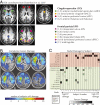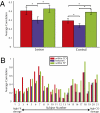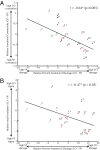Double dissociation of two cognitive control networks in patients with focal brain lesions
- PMID: 20547857
- PMCID: PMC2900657
- DOI: 10.1073/pnas.1002431107
Double dissociation of two cognitive control networks in patients with focal brain lesions
Abstract
Neuroimaging studies of cognitive control have identified two distinct networks with dissociable resting state connectivity patterns. This study, in patients with heterogeneous damage to these networks, demonstrates network independence through a double dissociation of lesion location on two different measures of network integrity: functional correlations among network nodes and within-node graph theory network properties. The degree of network damage correlates with a decrease in functional connectivity within that network while sparing the nonlesioned network. Graph theory properties of intact nodes within the damaged network show evidence of dysfunction compared with the undamaged network. The effect of anatomical damage thus extends beyond the lesioned area, but remains within the bounds of the existing network connections. Together this evidence suggests that networks defined by their role in cognitive control processes exhibit independence in resting data.
Conflict of interest statement
The authors declare no conflict of interest.
Figures





Similar articles
-
A novel approach to clinical-radiological correlations: Anatomo-Clinical Overlapping Maps (AnaCOM): method and validation.Neuroimage. 2007 Oct 1;37(4):1237-49. doi: 10.1016/j.neuroimage.2007.06.027. Epub 2007 Jul 12. Neuroimage. 2007. PMID: 17702605
-
Network measures predict neuropsychological outcome after brain injury.Proc Natl Acad Sci U S A. 2014 Sep 30;111(39):14247-52. doi: 10.1073/pnas.1322173111. Epub 2014 Sep 15. Proc Natl Acad Sci U S A. 2014. PMID: 25225403 Free PMC article.
-
Hubs of brain functional networks are radically reorganized in comatose patients.Proc Natl Acad Sci U S A. 2012 Dec 11;109(50):20608-13. doi: 10.1073/pnas.1208933109. Epub 2012 Nov 26. Proc Natl Acad Sci U S A. 2012. PMID: 23185007 Free PMC article.
-
Brain imaging of attentional networks in normal and pathological states.J Clin Exp Neuropsychol. 2001 Feb;23(1):74-93. doi: 10.1076/jcen.23.1.74.1217. J Clin Exp Neuropsychol. 2001. PMID: 11320446 Review.
-
Brain networks under attack: robustness properties and the impact of lesions.Brain. 2016 Dec;139(Pt 12):3063-3083. doi: 10.1093/brain/aww194. Epub 2016 Aug 6. Brain. 2016. PMID: 27497487 Review.
Cited by
-
Focal brain lesions to critical locations cause widespread disruption of the modular organization of the brain.J Cogn Neurosci. 2012 Jun;24(6):1275-85. doi: 10.1162/jocn_a_00222. Epub 2012 Mar 8. J Cogn Neurosci. 2012. PMID: 22401285 Free PMC article.
-
The salience network causally influences default mode network activity during moral reasoning.Brain. 2013 Jun;136(Pt 6):1929-41. doi: 10.1093/brain/awt066. Epub 2013 Apr 9. Brain. 2013. PMID: 23576128 Free PMC article. Clinical Trial.
-
Abnormal dynamic properties of functional connectivity in disorders of consciousness.Neuroimage Clin. 2019;24:102071. doi: 10.1016/j.nicl.2019.102071. Epub 2019 Nov 5. Neuroimage Clin. 2019. PMID: 31795053 Free PMC article.
-
Post-Stroke Cognitive Impairment: Pathophysiological Insights into Brain Disconnectome from Advanced Neuroimaging Analysis Techniques.J Stroke. 2021 Sep;23(3):297-311. doi: 10.5853/jos.2021.02376. Epub 2021 Sep 30. J Stroke. 2021. PMID: 34649376 Free PMC article. Review.
-
Abnormal Functional Network Topology and Its Dynamics during Sustained Attention Processing Significantly Implicate Post-TBI Attention Deficits in Children.Brain Sci. 2021 Oct 13;11(10):1348. doi: 10.3390/brainsci11101348. Brain Sci. 2021. PMID: 34679412 Free PMC article.
References
-
- Koechlin E, Ody C, Kouneiher F. The architecture of cognitive control in the human prefrontal cortex. Science. 2003;302:1181–1185. - PubMed
-
- Badre D, D'Esposito M. Functional magnetic resonance imaging evidence for a hierarchical organization of the prefrontal cortex. J Cogn Neurosci. 2007;19:2082–2099. - PubMed

